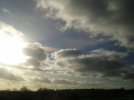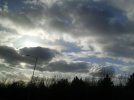Eol said:
<sniiiiiip>
And he also predicted a tropospheric cooling for the future / in opposite with a stratospheric warming with can be connected with what Gérald Messadié said :
the rapid growth of the differences between the troposphere and the upper layers can not proceed beyond a certain limit, as indicated by the laws of thermodynamics. An inversion can occur and even brutally.
This cooling of the uper atmosphere is realy fascinating. I know this subject only since a few months and i find very suspicious that we talk all day about the anthropogenic warming and very little about this cooling.
I've been thinking about this idea of upper atmosphere heating followed by an inversion. I think this is contradicted by plain evidence. Specifically, the increasing appearances of nacreous clouds at lower latitudes as well as the increase of contrails due to upper atmosphere cooling and that cooler air sinking lower, compressing the troposphere where the heating from within the earth is contained.
Another article about this appeared today: https://www.rt.com/uk/331006-strange-nacreous-clouds-uk/ which prompted me to mention this.
If you use nacreous as a search term on sott, you'll find that these have been increasing since at least 2006:
http://www.sott.net/article/117486-Rare-clouds-could-indicate-global-warming
01 Aug 2006
Rare, mother-of-pearl coloured clouds caused by extreme weather conditions above Antarctica are a possible indication of global warming, Australian scientists have announced.
Known as nacreous clouds, the spectacular formations showing delicate wisps of colours were photographed in the sky over an Australian meteorological base at Mawson Station on July 25.
The clouds can only form in temperatures lower than minus 80 degrees Celsius (minus 112 Fahrenheit). Meteorologist Renae Baker who photographed the clouds, said a weather balloon sent up about 12 miles above the Earth's surface measured temperatures as low as minus 87 Centigrade (minus 124.6 F). ...
Australian scientist Andrew Klekociuk said said temperatures in the stratosphere, between 5 and 31 miles above Earth, would be expected to drop as global warming increases. Data collected over the past 25 years had reflected this.
"Over that time there has been a small decrease in temperature and that change is actually occurring faster than the warming at the surface of the Earth," he said.
http://www.sott.net/article/148014-Mother-of-Pearl-Nacreous-Clouds
29 Jan 2008
As January comes to an end, sky watchers in Scandinavia are recovering from a veritable storm of nacreous clouds. After mid-month, hardly a night went by without someone spotting the phenomenon. "It was incredible! They were all over the sky," says Morton Ross of Oslo, Norway. ....
For much of January, these clouds rolled across the Arctic circle with puzzling regularity. Why the sudden abundance? Is the show over? No one knows. Stay tuned for February!
http://www.sott.net/article/171227-Nacreous-Clouds
21 Dec 2008
Nacreous clouds are located in the stratosphere some 9 to 16 miles high. Their iridescent "mother of pearl" colors come from sunlight striking tiny ice crystals inside the clouds. Very low temperatures near -85o C are required to form the crystals, which is why nacreous clouds are seen mainly during winter over places like Alaska, Iceland and Scandinavia.
These clouds are supposed to be rare, yet earlier this year Scandinavians witnessed a veritable "nacreous storm." For more than a week in January 2008, hardly a night went by without someone spotting mother-of-pearl colors in the sky. No one knows what caused the storm or if it could happen again. One thing is sure: northern sky watchers should be alert for more. The best time to look is during the twilight hours before dawn or after sunset.
http://www.sott.net/article/221107-Nacreous-Cloud-Alert
07 Jan 2011
Observers around the Arctic Circle are reporting vivid, iridescent nacreous clouds, which form in the stratosphere during the coldest months of northern winter.
http://www.sott.net/article/223422-CALIPSO-Spies-Polar-Stratospheric-Clouds
08 Feb 2011
NASA's Cloud-Aerosol Lidar and Infrared Pathfinder Satellite Observation (CALIPSO) satellite was in the right place at the right time earlier this month. On January 4, 2011, while flying over the east coast of Greenland, CALIPSO caught a top-down glimpse of an unusual atmospheric phenomenon - polar stratospheric clouds (PSCs), also known as nacreous clouds.
Clouds do not usually form in the stratosphere because of the dry conditions. But in the polar regions, often near mountain ranges, atmospheric gravity waves in the lower atmosphere (troposphere) can push just enough moisture into the high altitudes. The extremely low temperatures of the stratosphere condense ice and nitric acid into clouds that play an important role in depletion of stratospheric ozone. ...
The cloud was the result of mountain waves in the atmosphere, which form when stable air masses pass over mountains or high ice sheets, providing vertical lift. Pitts said such stratospheric ice clouds are rare because they only form when the jet stream in the Arctic is properly aligned with the edge of the polar vortex, a large air pressure system over the poles. The circulating air in the vortex needs to align with the jet stream to create enough vertical motion and propagate the waves to the upper atmosphere. The January 4 cloud was formed when those winds aligned and sent an air mass up over the high ice sheet and mountains of Greenland.
http://www.sott.net/article/239441-Beautiful-polar-stratospheric-clouds-forming-around-the-Arctic-Circle
29 Dec 2011
As December draws to a close, the first polar stratospheric clouds (PSCs) of northern winter are forming around the Arctic Circle. ...
The display Hagen witnessed formed in the wake of "Dagmar," a storm that "hit the coast of Norway with hurricane strength on Dec. 25th and 26th," says Hagen. "Record breaking winds up to 145 mph were recorded. While people on the coast dealt with the aftermath, photo enthusiasts inland saw the effects of high altitude winds in these colorful clouds. It was a beautiful display, but not comfortable to think of all the suffering lying behind it."
http://www.sott.net/article/240223-Polar-Stratospheric-Clouds
14 Jan 2012
An apparition of polar stratospheric clouds is underway around the Arctic Circle. "It is almost as good as the aurora borealis," says Göran Strand ...
Also known as "nacreous" or "mother of pearl" clouds, these icy clouds form in the lower stratosphere when temperatures drop to around minus 85ºC. Sunlight shining through tiny ice particles ~10µm across produce the characteristic bright iridescent colors by diffraction and interference.
"Nacreous clouds far outshine and have much more vivid colours than ordinary iridescent clouds, which are very much poor relations and seen frequently all over the world," writes atmospheric optics expert Les Cowley. "Once seen they are never forgotten."
http://www.sott.net/article/254548-Amazing-stratospheric-clouds-over-Europe
09 Dec 2012
When the sun set over the UK on Dec. 9th, sky watchers were stunned by an unexpected apparition of super-colorful stratospheric clouds. "They were amazing to see and a dream come true to photograph," reports Lesley Jennings of Fraserburgh, Aberdeenshire, Scotland. "There were all sorts of colors. I've never see the like before!" added Rachael Taylor also from Aberdeenshire. Nigel Feilden photographed this specimen from Inverurie, Scotland: ...
"Search for nacreous clouds at high latitudes (e.g., Scotland, Scandinavia, Iceland, Northern US) in winter and preferably downwind of mountains," Cowley advises. "They like stormy weather that perhaps creates gravity waves to loft the necessary moisture to make them upwards across the tropopause into the stratosphere. Once seen they are never forgotten!"
http://www.sott.net/article/264382-Comet-dust-loading-of-Earths-atmosphere-Nacreous-clouds-appear-over-Tierra-Del-Fuego
27 Jul 2013
On July 24th, about an hour after sunset, Gerardo Connon of Rio Grande city in Tierra del Fuego, Argentina, walked outside and witnessed a rare display of nacreous clouds. The colorful apparition was as bright as the street lights in the city below:
These clouds, also known as "mother of pearl clouds," form in the stratosphere far above the usual realm of weather. They are seldom seen, but when they are, the reports usually come from high-northern parts of our planet. This apparition over Tierra del Fuego was unusual indeed.
Atmospheric optics expert Les Cowley explains the special conditions required to create such a cloud: "Take an unusually cold lower stratosphere (15-25km high), use some gravity waves generated by high winds and storms in the troposphere to stir in some water vapour, and -- voilà! You get these clouds made of tiny ice crystals shining after sunset with unforgettably bright iridescent colors."
"The very special conditions make nacreous clouds a rare, high-latitude phenomenon. Scandinavia, Iceland and northern Canada are favourite places to see them. Sightings in the southern hemisphere are even more rare because there is so little land far enough south except for Antarctica."
23 Dec 2014
http://www.sott.net/article/290544-Polar-stratospheric-clouds-spotted-by-observer-in-Norway
Also known as "nacreous" or "mother of pearl" clouds, these icy structures form in the lower stratosphere when temperatures drop to around minus 85ºC. Sunlight shining through tiny ice particles ~10µm across produce the characteristic bright iridescent colors by diffraction and interference. Once thought to be mere curiosities, some PSCs are now known to be associated with the destruction of ozone.
15 Dec 2015: http://www.sott.net/article/308567-Colorful-mother-of-pearl-cloud-appears-in-Swedish-skies
http://www.sott.net/article/309322-Colorful-polar-stratospheric-clouds-return-to-Swedish-skies
27 Dec 2015
For the second time this month, sky watchers around the Arctic Circle are reporting an outbreak of colorful polar stratospheric clouds (PSCs). Also known as "nacreous" or "mother of pearl" clouds, icy PSCs form in the lower stratosphere when temperatures drop to around minus 85ºC.
http://www.sott.net/article/311276-Glowing-mother-of-pearl-clouds-color-Scotlands-skies
30 Jan 2016
These glowing polar stratospheric clouds were spotted floating over the UK on January 29, 2016.
There are probably more articles on sott that need a different search term to pull them up and undoubtedly many that we missed from the larger media.
Notice the "pat answers" that are formulated and included, more or less, in each of the reports. And the early attribution to "global warming."
Yeah, I think a sudden, brutal inversion is possible, it just ain't gonna be a hot stratosphere... just the opposite.






